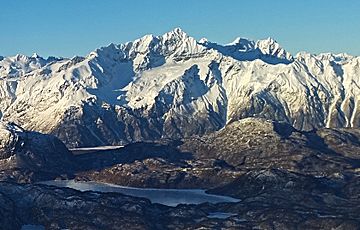Black Peak (Chigmit Mountains) facts for kids
Quick facts for kids Black Peak |
|
|---|---|

Black Peak, southeast aspect
Aerial view in winter |
|
| Highest point | |
| Elevation | 6,385 ft (1,946 m) |
| Prominence | 3,386 ft (1,032 m) |
| Isolation | 10 mi (16 km) |
| Parent peak | Double Peak (6,818 ft) |
| Geography | |
| Location | Lake Clark National Park Kenai Peninsula Borough Alaska, United States |
| Parent range | Chigmit Mountains Aleutian Range |
| Topo map | USGS Kenai D-7 |
| Climbing | |
| Easiest route | Mountaineering |
Black Peak is a tall mountain in Alaska, standing at 6,385 feet (1,946 meters) high. It is covered in glaciers and is found within Lake Clark National Park and Preserve. This peak is part of the Chigmit Mountains, which are a section of the larger Aleutian Range.
Black Peak is quite special because it's the second-highest non-volcanic mountain in the Chigmit Mountains. Overall, it ranks as the fourth-highest peak in this range. The mountain is located about 22 miles (35 km) west of Cook Inlet. It's also about 90 miles (145 km) west-southwest of Anchorage, a major city in Alaska. The closest taller mountain is Double Peak, which is about 10.2 miles (16.4 km) to the northeast.
Even though Black Peak isn't the tallest mountain in the world, it rises very steeply. It climbs about 6,200 feet (1,890 meters) from the North Fork Big River in just two miles. This makes it look very impressive and dramatic. The name "Black Peak" was officially given to the mountain in 1912 by the United States Coast and Geodetic Survey. If you want to see or climb Black Peak, the best time to visit is usually from May through June, when the weather is most favorable.
What is the Climate Like at Black Peak?
Black Peak is in a subarctic climate zone. This means it has very long, cold, and snowy winters. The summers are usually cool. Temperatures can drop below −20 °C (−4 °F), and with the wind chill, it can feel even colder, sometimes below −30 °C (−22 °F).
All the rain and snow that falls on the mountain, along with the melting ice from its glaciers, flows into the Big River. This river then carries the water all the way to Cook Inlet.


